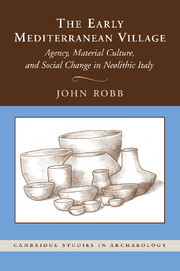Description
The Early Mediterranean Village
Agency, Material Culture, and Social Change in Neolithic Italy
Cambridge Studies in Archaeology Series
This book, first published in 2007, brings together the archaeological evidence on a wide range of aspects of life in Neolithic Italy.
Language: English
The Early Mediterranean Village
Publication date: 04-2014
Support: Print on demand
Publication date: 04-2014
Support: Print on demand
Peopling the past
Publication date: 07-2007
406 p. · 16x23.4 cm · Hardback
Publication date: 07-2007
406 p. · 16x23.4 cm · Hardback
Description
/li>Contents
/li>Biography
/li>
What was daily life like in Italy between 6000 and 3500 BC? In this book, first published in 2007, John Robb brings together the archaeological evidence on a wide range of aspects of life in Neolithic Italy and surrounding regions (Sicily and Malta). Exploring how the routines of daily life structured social relations and human experience during this period, Robb provides a detailed analysis of how people built houses, buried their dead, made and shared a distinctive cuisine, and made the pots and stone tools that archaeologists find. He also addresses questions of regional variation and long-term change, showing how the sweeping changes at the end of the Neolithic were rooted in and transformed the daily practices of earlier periods. Robb links the agency of daily life and the reproduction of social relations with long-term patterns in European prehistory.
1. Theorizing Neolithic Italy; 2. Neolithic people; 3. The inhabited world; 4. Daily 'economy' and social reproduction; 5. Material culture and projects of the self; 6. Neolithic economy as social reproduction; 7. Neolithic Italy as an ethnographic landscape; 8. The great simplification: large-scale change at the end of the Neolithic.
John Robb has lectured on archaeological theory and the European Neolithic at Cambridge University since 2001. He has conducted archaeological fieldwork on Neolithic and Bronze Age sites in Italy and has engaged in extensive research on prehistoric Italian skeletal remains. He edits the Cambridge Archaeological Journal.
© 2024 LAVOISIER S.A.S.
These books may interest you

The Neolithic of Britain and Ireland 160.25 €



